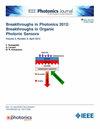Ultra-Wide-Band and Polarization-Insensitive Metamaterial Absorber With Resistive Ink Sheet for RCS Reduction Applications
IF 2.1
4区 工程技术
Q3 ENGINEERING, ELECTRICAL & ELECTRONIC
引用次数: 0
Abstract
This proposed work focuses on designing and evaluating planar and optimal metamaterial absorbers for radar stealth applications. The structure of the unit cell is designed using a dielectric FR4 substrate with resistive ink patterns printed on it. With the help of computational optimization using the Ansys HFSS tool, the proposed unit cell's various geometric parameters are fine-tuned to achieve outstanding results. The unit cell, which is designed with resistive ink-based lossy material printed on an FR-4 dielectric substrate, achieves a remarkable用于降低 RCS 应用的超宽带、偏振不敏感超材料吸收器与电阻墨层
这项工作的重点是设计和评估用于雷达隐形应用的平面和最佳超材料吸收器。单元单元的结构是利用印有电阻油墨图案的介电 FR4 基板设计的。在使用 Ansys HFSS 工具进行计算优化的帮助下,对所提出的单元单元的各种几何参数进行了微调,以获得出色的结果。在 FR-4 介质基板上印刷了基于电阻油墨的有损材料,设计出的单元单元在正常入射情况下,在 15 至 28.9 GHz 的频率范围内,反射率显著降低了 $-10$ dB,分数带宽达到 90%。此外,该结构的双负特性还能将 TE 和 TM 偏振波的反射降低 $-10$ dB,在所有频率上的角度可达 $60^{\circ}$。该设计具有四重旋转对称性,可实现对偏振不敏感的功能,从而增强了其通用性。此外,还分析了单元格的各种特性,包括介电常数、磁导率、折射率和阻抗图,以评估该设计。此外,还对表面电流和电场的分布进行了研究,从而进一步提高了设计的可信度。开发的原型具有新颖的单胞结构,还制作了各种单胞结构以进一步增强其功能,并对结果进行了测量和展示。实验结果与模拟结果相吻合,表明所提出的超材料吸收器是雷达隐形应用的最佳解决方案。
本文章由计算机程序翻译,如有差异,请以英文原文为准。
求助全文
约1分钟内获得全文
求助全文
来源期刊

IEEE Photonics Journal
ENGINEERING, ELECTRICAL & ELECTRONIC-OPTICS
CiteScore
4.50
自引率
8.30%
发文量
489
审稿时长
1.4 months
期刊介绍:
Breakthroughs in the generation of light and in its control and utilization have given rise to the field of Photonics, a rapidly expanding area of science and technology with major technological and economic impact. Photonics integrates quantum electronics and optics to accelerate progress in the generation of novel photon sources and in their utilization in emerging applications at the micro and nano scales spanning from the far-infrared/THz to the x-ray region of the electromagnetic spectrum. IEEE Photonics Journal is an online-only journal dedicated to the rapid disclosure of top-quality peer-reviewed research at the forefront of all areas of photonics. Contributions addressing issues ranging from fundamental understanding to emerging technologies and applications are within the scope of the Journal. The Journal includes topics in: Photon sources from far infrared to X-rays, Photonics materials and engineered photonic structures, Integrated optics and optoelectronic, Ultrafast, attosecond, high field and short wavelength photonics, Biophotonics, including DNA photonics, Nanophotonics, Magnetophotonics, Fundamentals of light propagation and interaction; nonlinear effects, Optical data storage, Fiber optics and optical communications devices, systems, and technologies, Micro Opto Electro Mechanical Systems (MOEMS), Microwave photonics, Optical Sensors.
 求助内容:
求助内容: 应助结果提醒方式:
应助结果提醒方式:


